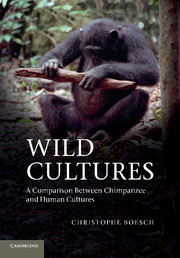Book contents
- Frontmatter
- Contents
- Acknowledgments
- Introduction
- 1 Studying culture in the wild
- 2 From human culture to wild culture
- 3 Shaping nature into home
- 4 One for all and all for one
- 5 I want to have sex with you
- 6 Learning culture
- 7 Dead or alive? Towards a notion of death and empathy
- 8 Wild culture – wild intelligence
- 9 Uniquely chimpanzee – uniquely human
- Epilogue: Will we have the time to study chimpanzee culture?
- References
- Index
9 - Uniquely chimpanzee – uniquely human
Published online by Cambridge University Press: 05 October 2012
- Frontmatter
- Contents
- Acknowledgments
- Introduction
- 1 Studying culture in the wild
- 2 From human culture to wild culture
- 3 Shaping nature into home
- 4 One for all and all for one
- 5 I want to have sex with you
- 6 Learning culture
- 7 Dead or alive? Towards a notion of death and empathy
- 8 Wild culture – wild intelligence
- 9 Uniquely chimpanzee – uniquely human
- Epilogue: Will we have the time to study chimpanzee culture?
- References
- Index
Summary
If [the intellectual and moral properties of man] were formerly of high importance to primeval man and to his ape-like progenitors, they would have been perfected or advanced through natural selection.
Charles Darwin, 1871: vol. 2: 153.How could “natural selection,” or survival of the fittest in the struggle for existence, at all favour the development of mental powers so entirely removed from the material necessities of savage men, and which even now, with our comparatively high civilization, are, in their farthest developments, in advance of the age …?
Alfred Wallace, 1870: 351–352Hadzaland, Tanzania, 21 July 2011
Sophia and her mother Madi are searching for tubers, their staple food source, during this long dry season. Digging sticks are essential tools for Hadza women, just as bows and arrows are essential for Hadza men. Sophia has been digging for some time already and her stick is becoming very short after all the sharpening she has done to it in the last few days. As she walks by some saplings, she uses her knife to cut a long stick from a Cordia bush and shortens it to a length of 1.6 m. This is the main type of sapling the Hadza use for their digging tools as they are hard enough to access the underground tubers. She carries her stick with her as she and some other women move along. Once they have moved about 50 m, Sophia picks up a stone, places one end of the stick on an outcropping rock and turns it while pounding the bark all around it. In that way, she slits the bark so as to be easily and completely removed. After hitting it eight times, she removes all the bark from this part of the stick, then turns it over and does the same thing to the other half. After 3 minutes, the stick is entirely peeled (see Figure 9.1). She then catches up with her mother and joins her in digging for more tubers. Moda, another woman who is foraging with them, lights a fire nearby and the women harden their sticks in it after having sharpened one end with their knives.
- Type
- Chapter
- Information
- Wild CulturesA Comparison between Chimpanzee and Human Cultures, pp. 215 - 238Publisher: Cambridge University PressPrint publication year: 2012



